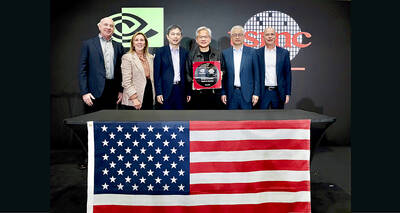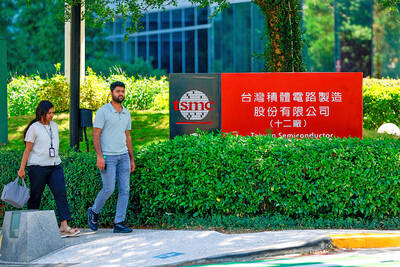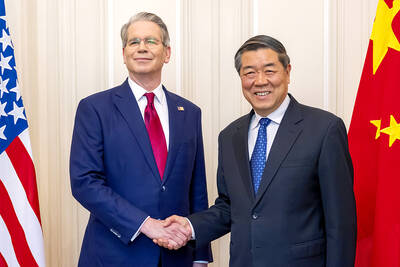The Far Eastern Air Transport Corp (FAT, 遠東航空) is planning to launch flights to Shenyang, Chongqing, Kinmen and Makung once aircraft and personnel pass Civil Aeronautics Administration (CAA) safety certification.
The Taipei District Court dismissed the executors and the supervisor of the FAT corporate restructuring team on Tuesday and replaced them with representatives from banks that loaned money to the financially troubled airline.
The banks said that the previous management had not been able to specify when and how necessary funding would come, nor was it able to submit a concrete financial restructuring plan.
The value of FAT would fall should they continue to serve, they added.
NEW CHIEF REP
The banks appointed former People First Party (PFP) legislator Liu Wen-hsiung (劉文雄) as their chief representative. Liu served on the Transportation Committee when he was a legislator.
“We estimate that the company probably needs NT$200 million [US$6 million] to NT$300 million to restart,” Liu said.
Airline management yesterday met the banks to negotiate a deal to start paying its employees again. Meanwhile, the airline is applying for CAA certification for four of its aircraft that have been grounded since the CAA suspended the airline’s operations last year.
Aviation regulations stipulate that the CAA ensure the aircraft are safe to fly.
Debt-ridden FAT filed for bankruptcy protection with the Taipei District Court in February of last year. After it failed to seek injections of capital from either new investors or major stock holders to ride out of financial crisis, FAT announced in May last year it would shut down its operations to stem losses and in June last year saw its rights to operate international air routes frozen by the CAA for six months.
“If everything goes as planned, we might have them ready for flights in October,” Liu said.
FAMILIAR PLACES
Jeacy Lee (李志熙), vice president customer service at FAT, said yesterday that the company did not have much choice in routes and had to stick with familiar destinations for the time being. Lee also said there was strong demand for flights to Kinmen and Makung.

RECYCLE: Taiwan would aid manufacturers in refining rare earths from discarded appliances, which would fit the nation’s circular economy goals, minister Kung said Taiwan would work with the US and Japan on a proposed cooperation initiative in response to Beijing’s newly announced rare earth export curbs, Minister of Economic Affairs Kung Ming-hsin (龔明鑫) said yesterday. China last week announced new restrictions requiring companies to obtain export licenses if their products contain more than 0.1 percent of Chinese-origin rare earths by value. US Secretary of the Treasury Scott Bessent on Wednesday responded by saying that Beijing was “unreliable” in its rare earths exports, adding that the US would “neither be commanded, nor controlled” by China, several media outlets reported. Japanese Minister of Finance Katsunobu Kato yesterday also

Jensen Huang (黃仁勳), founder and CEO of US-based artificial intelligence chip designer Nvidia Corp and Taiwan Semiconductor Manufacturing Co (TSMC, 台積電) on Friday celebrated the first Nvidia Blackwell wafer produced on US soil. Huang visited TSMC’s advanced wafer fab in the US state of Arizona and joined the Taiwanese chipmaker’s executives to witness the efforts to “build the infrastructure that powers the world’s AI factories, right here in America,” Nvidia said in a statement. At the event, Huang joined Y.L. Wang (王英郎), vice president of operations at TSMC, in signing their names on the Blackwell wafer to

‘DRAMATIC AND POSITIVE’: AI growth would be better than it previously forecast and would stay robust even if the Chinese market became inaccessible for customers, it said Taiwan Semiconductor Manufacturing Co (TSMC, 台積電) yesterday raised its full-year revenue growth outlook after posting record profit for last quarter, despite growing market concern about an artificial intelligence (AI) bubble. The company said it expects revenue to expand about 35 percent year-on-year, driven mainly by faster-than-expected demand for leading-edge chips for AI applications. The world’s biggest contract chipmaker in July projected that revenue this year would expand about 30 percent in US dollar terms. The company also slightly hiked its capital expenditure for this year to US$40 billion to US$42 billion, compared with US$38 billion to US$42 billion it set previously. “AI demand actually

RARE EARTHS: The call between the US Treasury Secretary and his Chinese counterpart came as Washington sought to rally G7 partners in response to China’s export controls China and the US on Saturday agreed to conduct another round of trade negotiations in the coming week, as the world’s two biggest economies seek to avoid another damaging tit-for-tat tariff battle. Beijing last week announced sweeping controls on the critical rare earths industry, prompting US President Donald Trump to threaten 100 percent tariffs on imports from China in retaliation. Trump had also threatened to cancel his expected meeting with Chinese President Xi Jinping (習近平) in South Korea later this month on the sidelines of the APEC summit. In the latest indication of efforts to resolve their dispute, Chinese state media reported that